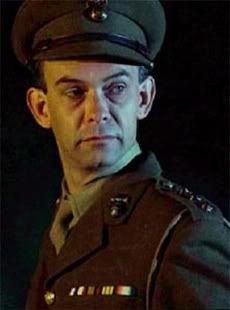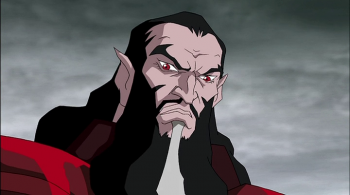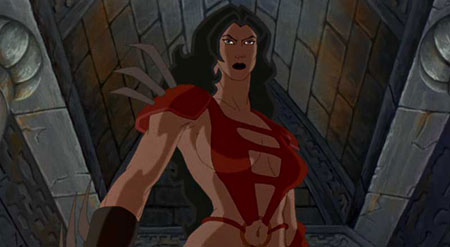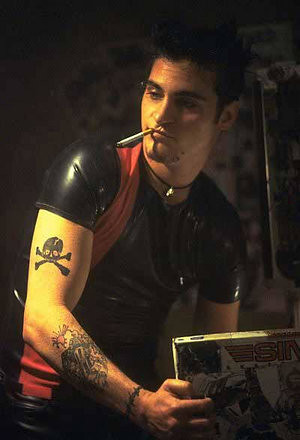Clive Barker's Hellraiser (1987) is considered by many to be one of the most unique horror films of the late 80's. What emphasized those opinions were gruesome images along with its gothic tone. A year later, New World Pictures released Hellraiser II: Hellbound (1988) and although it wasn't as critically praised, it still resonated with many fans. I found it enjoyable but the writing was much weaker than I had expected it to be. Then, jump four years later and we get Hellraiser III: Hell on Earth (1992), which to many just didn't satisfy and bordered on the edge of really bad. The sad thing is that, it is bad, even with the few good things it has going for it.
 |
| Terry Farrell as "Joey" |
The plot is about a "down on their luck" news reporter, Joey (Terry Farrell), who can't find a decent story to save her career. That is, until she comes into contact with the lament configuration after watching a hospital patient's head explode. Amazingly after being okay with such a traumatizing experience, this intrigues her more to find out what this tiny puzzle box is all about. To do this, she digs into the past using archives from Dr. Channard's mental asylum and interview footage of Kirsty Cotton. It is also explained to why Pinhead is back in this movie because in the movie before, he was killed off. This is one of the better parts, at least when it comes to the back-story and continuity. Peter Atkins, the same writer of Hellraiser II: Hellbound (1988), wrote the screenplay.
I'll admit, it's very much appreciated that Atkins' is keeping the continuity straight. If that wasn't at least on track, my rating would probably be lower. But even so, Atkins' ability to give explanations to why this mystical puzzle box decides to make various humans cenobites, and others not, makes no sense. Is it just by random chance? The cast on the other hand is another bowl of mixed nuts. It's great to see that the casting department had Ashley Laurence come back for a small cameo in the asylum footage and of course Doug Bradley as Pinhead himself. That was great, but the main lead, Terry Farrell wasn't. Farrell just didn't make her character come off as a strong female lead, no matter how many times one says "Go to hell!".
Unfortunately, dialog is another problem. I don't know what Atkins was thinking when it came to dialog, but almost every character here (and maybe even a little bit of Doug Bradley's lines) all have this sarcastic if not watered down dialog that makes them sound like these lines were written for a bad comedy. The Hellraiser franchise is not a comedy, not even a dark comedy, so why are characters making bad puns or being overly sarcastic? Even some of the new cenobites have corny dialog. For example, any female besides Joey (Farrell) wasn't that smart in speech or actions. What's up with that? It wasn't necessary then and it isn't now.
 |
Doug Bradley as his former character
Capt. Elliot Spencer |
Let's not forget though, this is a horror franchise so there will be plenty of death, blood and ugly images. And for those who wish to see that, yes, you will get your eye full worth without a doubt. But, if you're the viewer looking for the same kind of tone and chills you felt from Hellraiser (1987), it won't be found here. Even more surprising is how absent Randy Miller's score to the film was. I was actually impressed with his work from both Darkman II: The Return of Durant (1995) and Darkman III: Die Darkman Die (1996) because he not only made sure he stuck to the original theme, but added some unique tracks to them as well.
Here however, right from the intro credits is Christopher Young's music! It's not to say Miller didn't provide anything, because I know there were tunes in there I never heard before but it seemed like most of the music was just recycled and edited. It's sad when a composer comes off as sounding lazy – especially if they aren’t that bad to begin with. It's not to say this movie doesn't pull through, but its original tone and atmosphere of the picture no longer exists which makes it depressing that a franchise so likable is beginning to lose its charm. It's beginning to get to a point where the only reason why someone would want to watch this is for Pinhead alone. But Doug Bradley can't carry this picture by himself. Otherwise it would've worked from the first installment.
The third entry is much lighter in atmosphere and doesn't carry itself the way the first two did. The continuity is thankfully kept in order but the dialog isn't too clever and the only real character that’s worth a watch is Pinhead himself.
Points Earned --> 5:10

























